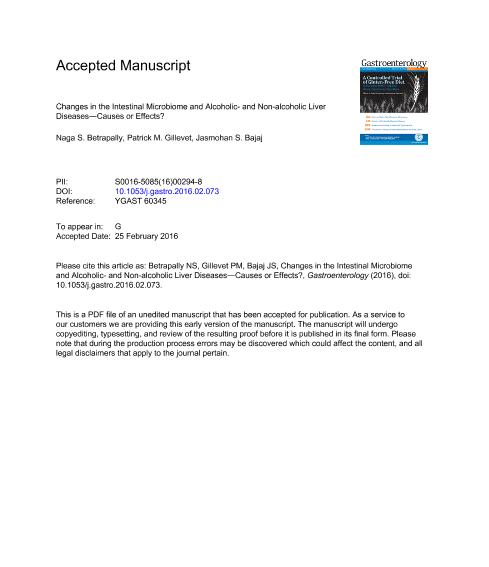Changes in the Intestinal Microbiome and Alcoholic and Nonalcoholic Liver Diseases: Causes or Effects?
摘要:The prevalence of fatty liver diseases is increasing rapidly worldwide; after treatment of hepatitis C virus infection becomes more widespread, fatty liver diseases are likely to become the most prevalent liver disorders. Although fatty liver diseases are associated with alcohol, obesity, and the metabolic syndrome, their mechanisms of pathogenesis are not clear. The development and progression of fatty liver, alcoholic, and nonalcoholic liver disease (NAFLD) all appear to be influenced by the composition of the microbiota. The intestinal microbiota have been shown to affect precirrhotic and cirrhotic stages of liver diseases, which could lead to new strategies for their diagnosis, treatment, and study. We review differences and similarities in the cirrhotic and precirrhotic stages of NAFLD and alcoholic liver disease. Differences have been observed in these stages of alcohol-associated disease in patients who continue to drink compared with those who stop, with respect to the composition and function of the intestinal microbiota and intestinal integrity. NAFLD and the intestinal microbiota also differ between patients with and without diabetes. We also discuss the potential of microbial therapy for patients with NAFLD and ALD.
关键词:
论文方向:[{"id":912,"name":"肿瘤学"}]
发表期刊:Gastroenterology Volume 150, Issue 8
发表时间:Thu Jun 30 00:00:00 CST 2016
数字识别码:10.1053/j.gastro.2016.02.073
是否作者本人: 否
版权及免责声明:
本网站所有论文文件均系用户自行上传或提供,本网站对其内容准确性及合法性概不负责,亦不承担任何法律责任。论文版权归原作者及原出处所有。
如您发现网站其他用户上传的论文有侵犯您的姓名权、隐私权、著作权或其他合法权益现象的,请及时与本网站联系并附加相关权利证明文件,以便本网站及时作出处理,维护您的合法权益。
本网站拥有对此声明的最终解释权。






{replyUser1} 回复 {replyUser2}:{content}